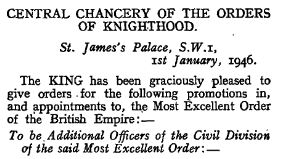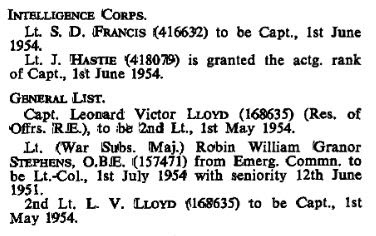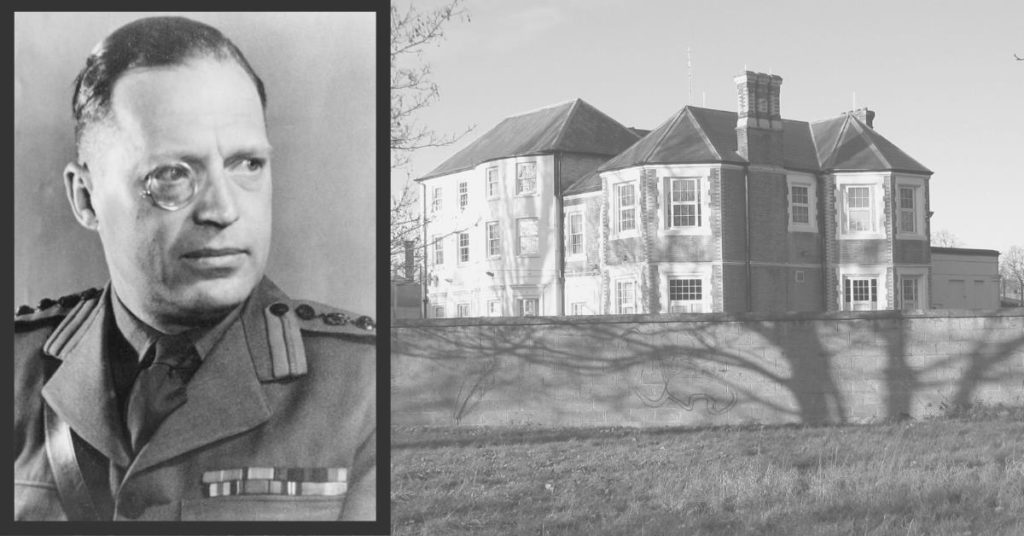I seem to be on a bit of a Stephens streak at the moment. While re-reading Chris Bilham’s Medal News article on Stephens, I noticed this bit:
“Stephens was awarded the OBE which was apparently ungazetted but was probably awarded at the end of the war.”
That same information appears in the DNW write-up for the auctioning of Stephens’ Indian General Service Medal.
It seemed strange to me that the OBE (Order of the British Empire) would be un-Gazetted and I did a bit of digging.
Wikipedia – 1946 New Year Honours
I had some success with Wikipedia which lists the New Year Honours for every year. I found Stephens listed for the 1946 New Year Honours.
The 1946 New Year Honours were appointments by many of the Commonwealth Realms of King George VI to various orders and honours to reward and highlight good works by citizens of those countries, and to celebrate the passing of 1945 and the beginning of 1946. They were announced on 1 January 1946 for the United Kingdom, and Dominions, Canada, the Union of South Africa, and New Zealand.

Stephens appears under Officer of the Order of the British Empire – Civil Division as “Colonel Robert William George Stephens, General Staff, War Office”.
Why he should appear under the Civil Division rather than the Military Division is a bit of a mystery, particularly as the OBE ribbon that Stephens wore seems to be that of the Military division (pearl-grey stripe down the centre).
The London Gazette

I then did a search through the Gazette which yielded nothing. Although, when I searched for +”Robert William George Stephens” +”Gazette” in Google, I did get a hit! It was listed in the Supplement to the London Gazette – 9 January 1946. But it was just the single page upon which Stephens’ name appeared, not the entire document with the actual division of the OBE.

After a bit of gymnastics using the Gazette search function, I was finally able to get the Supplements to appear in the searches but I came up empty for the period from 1/1/1946 to 31/01/1946, which is perplexing. I could see four pages of “Stephens” but none with Robert William George Stephens. I expanded the search parameters into December of 1945 and… success!!
Stephens appears on page 284 of Supplement 37412 from 28 December 1945, although it is apparently a Supplement for 9 January 1946.

Back track to page 275 and one can see that Stephens was indeed made an “Officer of the Civil Division of the said Most Excellent Order” of the British Empire.
Sooo… while I had briefly toyed with the idea that Wikipedia might have it wrong… I am still left wondering why Stephens was awarded an OBE to the Civil Division and why he wore a ribbon that would appear to be from the Military Division. Unless… Stephens objected to the Civil Division and campaigned for an OBE from the Military Division? Seems a bit odd but then… Stephens was a bit of an odd duck sometimes. I shared the Gazette information with Chris Bilham (author of the Medal News article on Stephens) and he agreed it was odd.
More Gazette Notices
I thought I would sift through the Gazette notices and see if I could find any further mention of Stephens. A few instances popped up…
London Gazette – 6 July 1954 – Supplement: 40223 – Page: 3955

This notice appeared under the general title of “Territorial Army” and bumps Stephens up to a lieutenant-colonel with seniority from 12 June 1951. The name “George” has been misspelled as “Granor” likely based on Stephens’ own application to the military in which his terrible handwriting does make “George” look like “Granor”. This particular entry was also indexed as “Rabin” not “Robin”.
London Gazette – 3 September 1954 – Supplement: 40270 – Page: 5128
A few months after the July notice, this additional notice appeared, again under the general title of “Territorial Army”.

Other than altering his rank from “Lt. (War Subs. Maj.)” in the earlier notice, to “Hon. Col.” in the later notice, there doesn’t seem to be much difference.
London Gazette – 30 November 1954 – Supplement: 40338 – Page: 677
And, just to complicate things further, another notice from November 1954…

In this third notice, Stephens is now “Lt.-Col. (Actg. Brig.).
The one thing all these notices can agree on is that he was a Colonel on 1 July 1954. Which likely means that the well-known photograph of Stephens (see above) was taken sometime after 1954.
London Gazette – 26 July 1960 – Supplement: 42103 – Page: 5215
The final Gazette notice is from late July 1960 and simply notes that Stephens retired on 23 June 1960 (his 60th birthday) and was granted the honourary rank of Brigadier.

None of these later notices help clear up the mystery of why Stephens might be wearing the OBE Military Division ribbon as opposed to the Civil Division ribbon. Perhaps there is a simple explanation? And some reader might know the answer?
Stephens’ Rank in the Photograph
The question from a few blog posts ago was… what is the rank of Stephens in the photograph. Is it Colonel or Lt Colonel? He is wearing the OBE ribbon so the photograph was taken after it was awarded in 1946. The Gazette notice for his OBE states that he was a Colonel, although later Gazettes note that he was a Lt (War Sub Major) or a Lt. Col (Actg. Col). So I guess the question becomes… does he wear his acting rank pips or his real rank pips? I would tend to think he would wear his acting rank insignia and, given that he is listed as a Colonel for the 1946 OBE, I tend to think that he would have worn Colonel pips. Although I am open to correction from readers! I am no military expert by any means…
At the same time, I thought I would check the court martial documents from 1948. The newspapers are no help for they variously refer to him as Colonel and Lt. Colonel, in the same article. A quick glance at the court martial documents show that he is listed as a Lt. Colonel in 1948 sooo… that is no help. Technically, according to the 1954 Gazette, he was only given the rank of Lt. Col with effective seniority dated 1951.
And… just to confuse things a bit more, I looked in his army personnel file and… he was a Lt. Col. on 15 September 1941 and then a Local Colonel on 20 April 1944.

I also found a note in his file from when he was appointed Commandant (Col) of Bad Nenndorf (no date on the form), which suggests he was a Colonel (despite only being a W/Lt. Colonel. Sooo confusing… Thoughts, anyone?
N.B. 2020 11 29
Nick Hinton, former Lt. Col with the Second Gurkhas sent me some thoughts on the OBE:
People in the intelligence services get awarded ‘civil’ versions of medals when available because they are civil servants. Although he wore military uniform, Stephens was carrying out a civil function during the war and so would have qualified for the civilian medal. As we’ve discussed before, Stephens may have worn the military medal ribbon either because he disliked the idea of wearing a ‘civilian’ medal or because of genuine ignorance that he was wearing the wrong one.
And, regarding the various rank options (local, acting temporary, war sub, honorary)… Nick shared these thoughts:
The plethora of different types of rank can be very confusing, particularly in wartime. If you have local rank you wear the appropriate badges but don’t get paid for that rank, only at the level of your substantive or acting rank (whichever is higher). If you have acting rank (e.g. to temporarily occupy a particular appointment) you both wear the badges and get paid, but each Regiment has different quirks which differentiate acting and substantive rank (for example, in mine only substantive majors and above wore spurs in mess kit; acting majors and below did not). You are also allowed to wear the badges of honorary rank (and previously brevet rank – long since defunct) but the financial aspects of honorary rank have varied a great deal over the years and depend on circumstances: while serving, for example, Stephens would probably not have got any financial benefit from his Honorary Rank, but may have accrued additional pension benefits which kicked in when he retired.
Thanks for the thoughts!

Hello.
Great blog as ever. I can confirm that Lt Col Hinton (Ret) is correct to say that members of the (non-military) intelligence services, such as MI5 or MI6, receive civilian awards, even if they have a rank and are listed in various public documents as members of the armed forces. Apart from the explanation given – that the awardee is exercising a civilian function, not a military one – the other issue is one of "cover". This is particularly so during war time, when an apparently able-bodied man in civilian dress might arouse suspicion. A man in uniform would not. But it is a general security precaution as well.
Moreover, appearing in military attire at various meetings and so forth also helps conceal that the wearer is a "spook", though I dare say many of Col. Stephens' interlocutors knew that when he said "War Office" – a cover name for MI5 during the war – he was not likely referring to the actual war office.
Preserving cover during employment and ones former employment even when one retires, is a life-long duty. Hence the 1960 Gazette announcement. As well, the UK government did not officially acknowledge that MI5 existed until the 1980s – I think it was the Spycatcher trial in Australia. MI6 was similarly officially acknowledged in the 1980s.
There is also an amusing story, I can't remember who told it, that the writer was summoned to an interview with a certain "Captain Black" RNVR, at the war office during the early stages of the war. He was ushered in to the interview, asked some seemingly innocuous questions. Then Captain Black rose to say that the interviewee had been successful and a job offer would be made in writing within a day or two. As he left the room, Captain Black retrieved a greatcoat from a wardrobe. The interviewee saw inside a row of neatly hanging military uniforms – RAF, Army, Marines, Highland regiments, and so on and officer ranks up to Colonel.
Captain Black saw that his guest was puzzled but was utterly unperturbed.
"I do have a question, Captain?
"Oh?"
"What part of the military was this interview for?"
"Oh, old boy, you've just joined MI5. We will see you Monday. Remember, Mum's the word."
I thought it was an amusing yarn, but then during my career met an actual retired MI5 person – this is some years ago – and asked her.
"Oh yes; that's actually quite true. I've met the man". She then proceeded to tell me some other very amusing stories but I'll keep them to myself.
Thanks for the comment. Love the story about Captain Black! The awarding of the civil OBE certainly makes sense to me now. Still find it odd he would wear a military ribbon with it… unless that too was part of his cover. Why, after all, would a military man be wearing a civilian OBe?